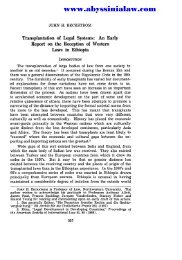Download - Abyssinia Law
Download - Abyssinia Law
Download - Abyssinia Law
You also want an ePaper? Increase the reach of your titles
YUMPU automatically turns print PDFs into web optimized ePapers that Google loves.
Vol. 40, No. 1<br />
www.abyssinialaw.com<br />
Tort law and development<br />
in (developing) Western countries." Indeed, considering the phenomenon of<br />
dualism (with its formal and informal market) and the massive presence of<br />
Western market actors, the efficient solution might call for a co-existence of tort<br />
law models. If the goal is to favour the growth of local enterprises which can<br />
play a role in the informal market, and not to sterilize the beneficial effects of<br />
foreign investment, a balanced tort law must use both strict liability and negligence<br />
rules. In the short and medium term, more friendly negligence law rules focused<br />
on a level of care positioned to guarantee the efficient level of precaution is<br />
probably advisable for damage created by local entrepreneurs: such levels should<br />
consider the foreseeability of the harm for a less equipped market actor.<br />
On the other hand, strict liability, possibly focused on a market share<br />
mechanism, may be the most efficient rule to apply to Western investors and to<br />
public-owned local corporations. True, damages can be difficult to account<br />
for, but-besides the traditional justification grounded on the deep pocket<br />
argument-it would be sufficient to introduce devices (such as minimum levels<br />
of compensation related to a typical series of events) in order to make it possible<br />
to over-estimate rather than under-estimate damages, thus introducing a subsidy<br />
effect on the informal economy.<br />
One should also consider the introduction of an insurance regime able to<br />
reflect the needs of weaker market actors. In a context in which the insurance<br />
market is not perfectly competitive, local enterprises should be allowed to<br />
purchase third-party insurance policies with low (maximum) ceilings for compensation.<br />
Such limits, by keeping low the cost of liability insurance (that is<br />
premium rates, which are usually graduated according to those ceilings of<br />
compensation), should favour the diffusion of third-party insurance also at this<br />
level. Stronger market actors may furthermore find incentives thereby to purchase<br />
first-party insurance, since they may be affected by the low level of compensation<br />
covered by insurance in case of harm created by weaker market actors (insured<br />
third parties).<br />
AN EFFIc INTERNATIONAL ENVIRONMENTAL TORT LAW?<br />
An approach to environmental problems is to look at them from a transnational<br />
perspective. At this level, the scarcity of concrete results is bewildering. The<br />
international community has so far adopted around 200 environmental agreements<br />
covering atmospheric, marine and land pollution, protection of wild life<br />
and preservation of shared global resources. Most of these agreements were<br />
reached after the environmental emergencies of the 1970s. While some have<br />
been satisfactory, others remain largely rhetoric.<br />
The best solution to such problems might be to re-think the allocation of<br />
Western aid, not only to re-direct resources in favour of non-polluting businesses<br />
(preferably engaged in producing primary goods), but also to promote a legal<br />
education which will foster a local legal culture and consciousness. This alternative<br />
respects freedom, gives individuals responsibility and, most importantly, does<br />
not impair the process of development. It promotes the development of specifically<br />
local legal rules to be applied by judges who should be the best product of their<br />
own legal culture. These judges should not be bureaucrats or politicians. They<br />
should be technocrats, social engineers and, most of all, scholars on the bench.<br />
48 At that time, as has been seen (nn. 2 and 3), a vast number of growing industrial activities<br />
were allowed to externalize their costs with appalling consequences for the environment.





